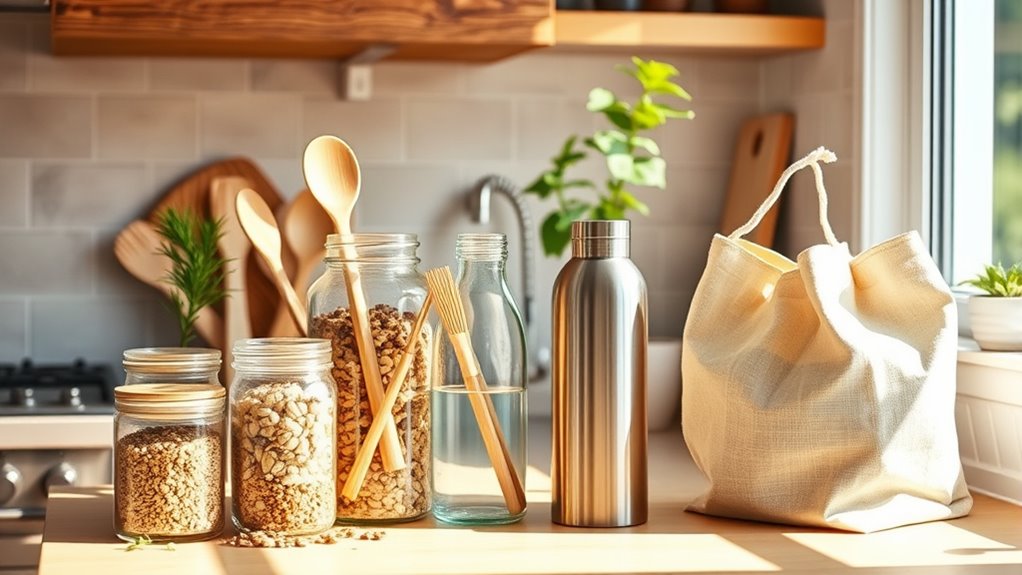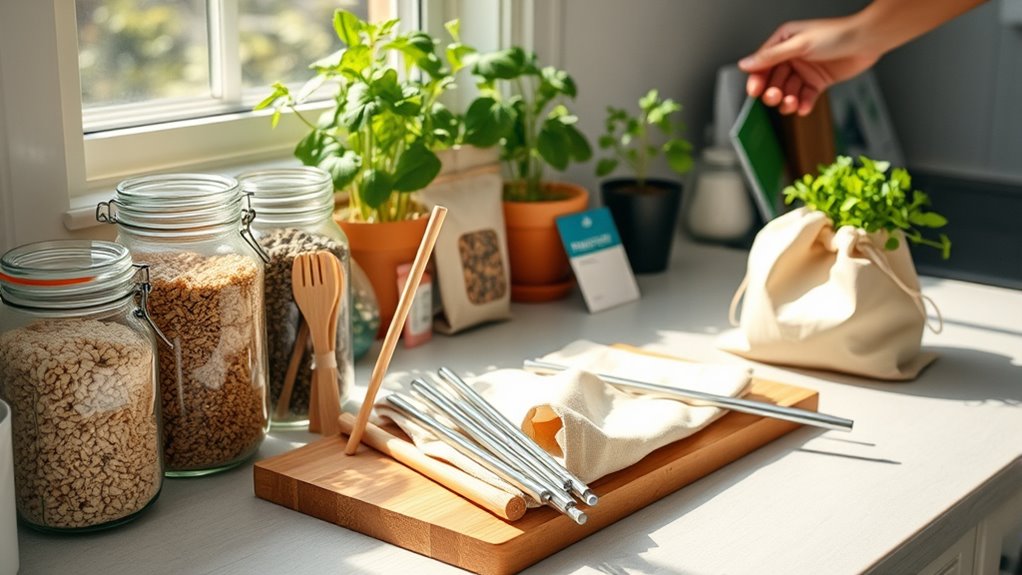To go plastic-free in 30 days, start replacing single-use plastics with reusable items like metal bottles, cloth bags, and containers. Plan your shopping to buy in bulk, choose unpackaged products, and bring your own bags and jars. Purchase larger bottles of cleaning supplies and refills to reduce waste. Keep a reusable kit handy and be mindful of packaging choices. Stick with small, consistent changes, and you’ll discover more practical tips to make a lasting impact.
Key Takeaways
- Replace single-use plastics with reusable bottles, bags, containers, and produce wraps to reduce waste immediately.
- Plan shopping trips with reusable kits and buy in bulk to minimize packaging and impulsive plastic purchases.
- Choose loose, unpackaged items and refillable products to cut down on pre-packaged plastic waste.
- Properly recycle or reuse plastic packaging and stay informed about eco-friendly disposal options.
- Develop daily habits of mindful consumption and waste reduction to sustain a plastic-free lifestyle over 30 days.

Reducing plastic use can seem overwhelming, but taking small, deliberate steps makes a big difference. One of the easiest ways to start is by replacing single-use plastic items with reusable alternatives. Think about your daily routines—swap plastic water bottles for a durable metal or glass bottle, and replace disposable shopping bags with cloth or sturdy tote bags. Reusable alternatives not only cut down on waste but also save you money in the long run. When shopping, focus on bringing your own containers for bulk items, fruits, and vegetables. This habit helps eliminate the need for plastic produce bags and packaging, making your shopping trips more eco-friendly.
Start small: switch to reusable water bottles, bags, and containers to make a big eco-friendly impact.
To make these changes seamlessly, adopt some smart shopping tips. Before heading out, plan your purchases and bring along reusable bags, jars, and containers. Check store policies; many places now encourage bringing your own bags and containers and may even offer discounts for doing so. When shopping for groceries, choose loose items over pre-packaged ones. For example, pick up apples, carrots, and grains in bulk sections rather than pre-packaged options. This reduces plastic waste and allows you to buy only what you need, minimizing food waste too. If you find yourself with excess plastic packaging, consider reusing or recycling these items properly.
Another useful shopping tip is to buy in larger quantities when possible. Purchasing larger bottles of shampoo, soap, or cleaning supplies reduces the frequency of packaging waste. Bring your own refillable bottles to stores that offer refilling stations—many now do—further cutting down on plastic waste. When shopping for clothes and household items, opt for brands committed to sustainable packaging or packaging-free options. Additionally, staying informed about vetted recycling options can help properly dispose of plastics you cannot reuse, ensuring they are processed responsibly.
It’s also helpful to keep a reusable shopping kit in your car or bag—containing cloth bags, produce bags, and a set of containers—so you’re always prepared. This minimizes impulsive purchases of single-use plastics and keeps your goal of a plastic-free lifestyle on track. Remember, it’s not about perfection but consistency. Small, mindful choices add up over time and considerably impact reducing plastic waste.
Frequently Asked Questions
Can I Go Completely Plastic-Free With My Current Lifestyle?
You can definitely reduce your plastic use, but going completely plastic-free with your current lifestyle might be challenging. It requires personal lifestyle adjustments, like choosing reusable alternatives and avoiding single-use plastics. Your current plastic habits may need significant changes, but small steps make a difference. Focus on progress, not perfection, and gradually replace plastic items. Over time, these efforts can lead to a more sustainable, plastic-free lifestyle tailored to your habits.
What Are the Best Plastic-Free Alternatives for Kids’ Products?
You want safe, eco-friendly options for your kids? Switch to biodegradable toys instead of plastic ones—they break down naturally and are safer. Use silicone snack bags for snacks, replacing single-use plastic bags. These alternatives are durable, reusable, and free of harmful chemicals. By choosing biodegradable toys and silicone snack bags, you protect your children and the environment, making sustainable living a natural part of your family’s daily routine.
How Do I Handle Plastic Packaging on Online Orders?
When you receive online orders with plastic packaging, start by carefully removing and reusing or recycling it through local recycling programs. Look for brands that prioritize eco-friendly packaging options or offer minimal plastic. You can also advocate for companies to adopt sustainable practices. By taking these steps, you help reduce plastic waste and encourage more businesses to switch to environmentally friendly packaging solutions.
Are There Any Hidden Plastics in Household Electronics?
You might be surprised to find tiny microplastic pollution lurking inside household electronics, often hidden in cables, screens, or battery casings. These little bits contribute to electronic waste and can shed microplastics over time. To reduce your impact, choose eco-friendly gadgets, recycle electronics properly, and stay informed about materials used. Being mindful helps you minimize hidden plastics and support a cleaner environment, even in everyday devices.
How Can I Stay Motivated During the Plastic-Free Journey?
Staying motivated is key to your plastic-free journey. Use motivational techniques like setting small, achievable goals and tracking your progress. Join support networks or online communities to share your experiences and gain encouragement. Remember why you started, and celebrate your victories along the way. Surrounding yourself with like-minded people keeps you inspired and accountable, helping you stay committed and motivated throughout your plastic-free adventure.
Conclusion
Imagine your journey to a plastic-free life as tending a delicate garden. With each mindful choice, you plant seeds of change, watching as your efforts grow into a lush, sustainable landscape. Every small act is a drop of water nurturing this garden, shaping a future where nature thrives. Stay committed, and over time, you’ll witness a vibrant oasis emerge—proof that even a single individual can cultivate a world of lasting beauty and balance.









